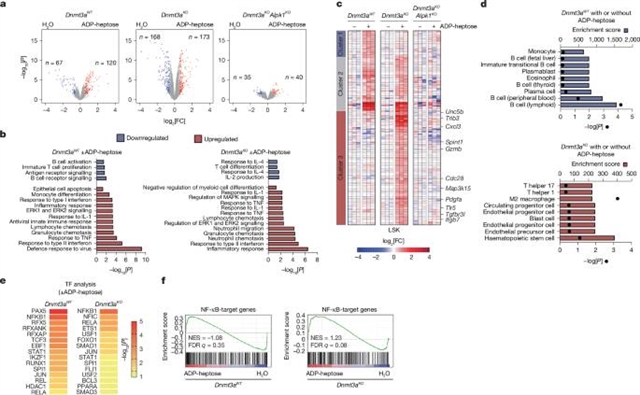
美国辛辛那提儿童医院医疗中心Daniel T. Starczynowski小组报道了微生物代谢物通过ALPK1驱动衰老相关克隆造血。这一研究成果发表在2025年4月23日出版的国际学术期刊《自然》上。
本研究表明,随着年龄的增长,肠道的改变会导致促进白血病前期细胞扩张的微生物代谢物的全身传播。具体来说,ADP-D-glycero-β-D-manno-heptose (ADP-heptose)是一种革兰氏阴性细菌特异性的生物合成副产物,仅存在于老年人的血液循环中,有利于白血病前期细胞的扩张。ADP-heptose也与CHIP患者炎症和心血管风险增加有关。从机制上讲,ADP-heptose与其受体ALPK1结合,触发转录重编程和NF-κB激活,使白血病前期细胞因过度克隆增殖而具有竞争优势。总的来说,课题组人员发现ADP-heptose的积累代表了罕见的白血病前期细胞衰老和扩张之间的直接联系,这表明ADP-heptose–ALPK1轴是一个有希望的治疗靶点,可以防止CHIP进展为显性白血病和免疫相关疾病。
据悉,潜在不确定克隆造血(CHIP)涉及突变白血病前造血细胞的逐渐扩增,随着年龄的增长而增加,并带来多种疾病的风险,包括白血病和免疫相关疾病。尽管CHIP患者转化为白血病的绝对风险非常低,但最有力的预测因子是突变造血细胞的积累。尽管已知CHIP与全羧化酶死亡率增加之间存在关联,但他们对衰老过程中这一过程背后的环境和调节因素的理解仍处于初级阶段。
附:英文原文
Title: Microbial metabolite drives ageing-related clonal haematopoiesis via ALPK1
Author: Agarwal, Puneet, Sampson, Avery, Hueneman, Kathleen, Choi, Kwangmin, Jakobsen, Niels Asger, Uible, Emma, Ishikawa, Chiharu, Yeung, Jennifer, Bolanos, Lyndsey, Zhao, Xueheng, Setchell, Kenneth D., Haslam, David B., Galloway-Pena, Jessica, Byrd, John C., Vyas, Paresh, Starczynowski, Daniel T.
Issue&Volume: 2025-04-23
Abstract: Clonal haematopoiesis of indeterminate potential (CHIP) involves the gradual expansion of mutant pre-leukaemic haematopoietic cells, which increases with age and confers a risk for multiple diseases, including leukaemia and immune-related conditions1. Although the absolute risk of leukaemic transformation in individuals with CHIP is very low, the strongest predictor of progression is the accumulation of mutant haematopoietic cells2. Despite the known associations between CHIP and increased all-cause mortality, our understanding of environmental and regulatory factors that underlie this process during ageing remains rudimentary. Here we show that intestinal alterations, which can occur with age, lead to systemic dissemination of a microbial metabolite that promotes pre-leukaemic cell expansion. Specifically, ADP-D-glycero-β-D-manno-heptose (ADP-heptose), a biosynthetic bi-product specific to Gram-negative bacteria3,4,5, is uniquely found in the circulation of older individuals and favours the expansion of pre-leukaemic cells. ADP-heptose is also associated with increased inflammation and cardiovascular risk in CHIP. Mechanistically, ADP-heptose binds to its receptor, ALPK1, triggering transcriptional reprogramming and NF-κB activation that endows pre-leukaemic cells with a competitive advantage due to excessive clonal proliferation. Collectively, we identify that the accumulation of ADP-heptose represents a direct link between ageing and expansion of rare pre-leukaemic cells, suggesting that the ADP-heptose–ALPK1 axis is a promising therapeutic target to prevent progression of CHIP to overt leukaemia and immune-related conditions.
DOI: 10.1038/s41586-025-08938-8
Source: https://www.nature.com/articles/s41586-025-08938-8
Nature:《自然》,创刊于1869年。隶属于施普林格·自然出版集团,最新IF:69.504
官方网址:http://www.nature.com/
投稿链接:http://www.nature.com/authors/submit_manuscript.html
